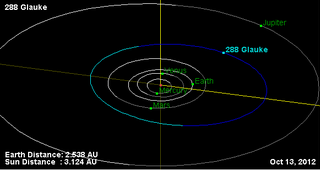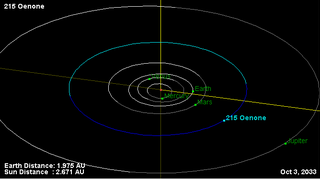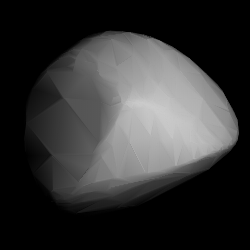
288 Glauke is a stony, tumbling asteroid and slow rotator from the intermediate asteroid belt, approximately 32 kilometers in diameter. It was discovered on 20 February 1890, by Robert Luther at Düsseldorf-Bilk Observatory in Germany. It was the last of his asteroid discoveries. It is named after Creusa, a daughter of Creon, a king of Corinth in Greek mythology.

128 Nemesis is a large 180 km main-belt asteroid, of carbonaceous composition. It rotates rather slowly, taking about 78 hours to complete one rotation. Nemesis is the largest member of the Nemesian asteroid family bearing its name. It was discovered by J. C. Watson on 25 November 1872, and named after Nemesis, the goddess of retribution in Greek mythology.

207 Hedda is a sizeable Main belt asteroid. It is a C-type asteroid, meaning it is primitive in composition and dark in colour. This asteroid was discovered by Johann Palisa on October 17, 1879, in Pola and was named after Hedwig Winnecke, wife of astronomer Friedrich A. T. Winnecke.

215 Oenone is a typical main belt asteroid. It was discovered by the Russian astronomer Viktor Knorre on April 7, 1880, in Germany, and was the second of his four asteroid discoveries. The asteroid is named after Oenone, a nymph in Greek mythology.

227 Philosophia is a large main-belt asteroid that was discovered by the French astronomer Paul-Pierre Henry on August 12, 1882, in Paris and named after the topic of philosophy. Based upon photometric observations, it has a synodic rotation period of 52.98 ± 0.01 with a brightness variation of 0.15 ± 0.02 in magnitude.

231 Vindobona is a large Main belt asteroid. It was discovered by Austrian astronomer Johann Palisa on September 10, 1882. Vindobona is the Latin name for Vienna, Austria, the city where the discovery was made.
232 Russia is a large Main belt asteroid. It is classified as a C-type asteroid and is probably composed of primitive carbonaceous material. It was discovered by Johann Palisa on 31 January 1883 in Vienna, who named it after the country of Russia.

340 Eduarda is a main belt asteroid that was discovered by German astronomer Max Wolf on 25 September 1892 in Heidelberg. It was named after German banker and amateur astronomer Heinrich Eduard von Lade.

362 Havnia is a typical Main belt asteroid.
538 Friederike is a minor planet orbiting in the asteroid belt. It is a member of the Hygiea family of asteroids.
618 Elfriede is a minor planet orbiting the Sun. On July 24, 2013, it occulted the magnitude 12.8 star 2UCAC 23949304, over parts of Mexico and southwestern United States.
745 Mauritia is a dark background asteroid from the outer regions of the asteroid belt, approximately 24 kilometers in diameter. It was discovered on 1 March 1913, by German astronomer Franz Kaiser at the Heidelberg-Königstuhl State Observatory in Germany. The presumed carbonaceous C-type asteroid has a rotation period of 9.9 hours. It was named after Saint Maurice, patron of the Saint Mauritius church in the city of Wiesbaden, where the discoverer was born.
815 Coppelia is a minor planet orbiting the Sun that was discovered by German astronomer Max Wolf on 2 February 1916 from Heidelberg named after Coppélia, a comic ballet.
820 Adriana, provisional designation 1916 ZB, is an exceptionally dark asteroid from the outer region of the asteroid belt, about 59 kilometers in diameter. It was discovered by German astronomer Max Wolf at Heidelberg Observatory in southern Germany, on 30 March 1916.
851 Zeissia is an S-type asteroid background asteroid from the inner region of the asteroid belt. Its diameter is about 12 km and it has an albedo of 0.2646 . Its rotation period is 9.34 hours.
860 Ursina is a minor planet orbiting the Sun that was discovered in 1917 by German astronomer Max Wolf. The origin of the name is unknown.
967 Helionape is an asteroid belonging to the Flora family of Main Belt asteroids. It was discovered by German astronomer Walter Baade at Hamburg Observatory on November 9, 1921, and was named after the Austrian theatrical actor Adolf von Sonnenthal. This object is orbiting the Sun at a distance of 2.23 AU with a period of 3.32 years and an eccentricity of 0.168. The orbital plane is inclined at an angle of 5.4° to the ecliptic.

979 Ilsewa is a background asteroid from the outer regions of the asteroid belt, approximately 36 kilometers in diameter. It was discovered by German astronomer Karl Reinmuth at the Heidelberg-Königstuhl State Observatory on 29 June 1922. The uncommon T-type asteroid has a longer-than average rotation period of 42.6 hours. It was named after Ilse Walldorf, an acquaintance of the discoverer.
999 Zachia is a main-belt asteroid that was discovered by German astronomer Karl W. Reinmuth in 1923 and named after Hungarian astronomer Franz Xaver von Zach.
9344 Klopstock, provisional designation 1991 RB4, is a background asteroid from the inner regions of the asteroid belt. It was discovered on 12 September 1991, by German astronomers Freimut Börngen and Lutz Schmadel at the Karl Schwarzschild Observatory in Tautenburg, Germany. Poor observational data suggests that the asteroid is one of the darkest known objects with a diameter of approximately 17 kilometers (11 miles), while it is also an assumed stony asteroid with a much smaller diameter. It has a rotation period of 5.84 hours and was named after German poet Friedrich Gottlieb Klopstock.









